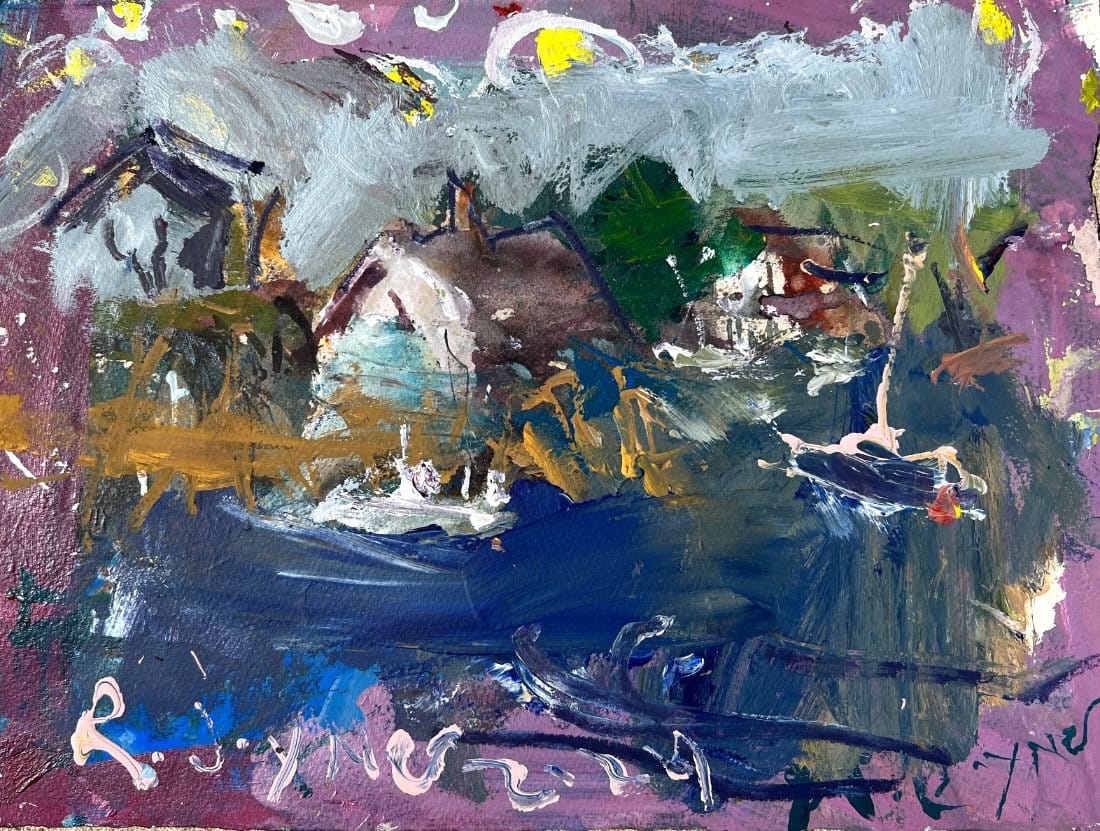Discover How to Turn Bad Art into Expressive Landscape Artwork
That painting sitting in the corner that's been annoying you for weeks? The one you started as watercolor, added acrylics to, then shoved aside in frustration? Don't throw it away, here's why...

That painting sitting in the corner that's been annoying you for weeks? The one you started as a watercolor, maybe added some acrylics to, experimented with a few patterns, then shoved aside in frustration? Don't throw it away.
Those "failed" paintings are actually goldmines for creating expressive landscape work.
👉 Four Studio-Tested Ways to Start Loose Paintings - discover more ways to paint expressively.
👉 Discover more mixed media painting techniques in my Mixed Media Hub
The Power of Having Nothing to Lose
I have a stack of smaller paintings - usually 11x15 - that serve as my experimental playground. This particular piece started out as a watercolor, then I added acrylics over it, even experimented with some circular patterns with yellow centers. It's been through multiple iterations, and honestly, it got on my nerves more than once.
But here's what I've learned: when you put a painting aside for a week, a month, whatever - you often come back and see opportunities or beauty that you completely missed before.
That's the magic of working with paintings you don't really care about. There's nothing to lose. You can smear out areas you don't like, flip the canvas over and press it into wet paint, try techniques where you can't predict the results.

Unpredictable Techniques Build Real Skills
I love using methods where I have a general idea of what might happen, but can't control exactly how it turns out. Like flipping the canvas over and pressing it into wet paint to create random smudged areas. You're putting yourself in positions where you have to problem-solve your way out.
This is exactly like life experience. At first, these skills and techniques feel foreign. But you do them a few times, build up experience, and suddenly you can handle situations that used to feel awkward or unfamiliar.
👉 What Actually Makes Painting Expressive - my ideas for dining expressive artwork
👉 What Makes an Expressive Landscape Painting - love loose, expressive landscapes? Have a look at this article.
Painting works the same way. You've got to continue putting yourself in these positions where you're thinking "oh my gosh, this is a big mess, what am I going to do?" Then you work your way through it. Next thing you know, you have more techniques and experience to draw from.
The Random Doodling Approach
A lot of what I do is essentially random doodling - though not 100% random since I'm usually trying to get some kind of coastal scene with boats. But when things don't work out, I just smudge them, smear them, play with colors.
Maybe I'll add a little pink to a boat that wasn't working. If I want some quiet space in the background, I'll smear out what was there to create an area where linear marks will show up clearly.
That's key - creating quiet areas so you can add linear interest later. I use artist-grade crayon to add outlines and scribbles, but they only work if there's a relatively calm background for them to show against.
Building Experience Through Experimental Layers
The mixed media approach - watercolor base, acrylic layers, pattern experiments, linear elements - creates paintings that couldn't happen any other way. Each layer responds to what came before, building complexity that you could never plan from the start.
When I added that little pier in the foreground and didn't like it, I just smeared it out. No big deal. That's the beauty of working this way - every "mistake" becomes material for the next layer.
Why This Approach Works
These experimental sessions using paintings I'm not precious about have taught me more about creating expressive landscape work than any careful, planned painting could. You build confidence by working through problems you can't control.
In the future, when you're working on a painting you do care about, you'll remember: "Oh yeah, I just persevered, did this and that, and it didn't turn out too bad."
That experience of problem-solving through messy, unpredictable situations is exactly what creates the kind of confident, expressive mark-making that makes landscape paintings come alive.
Don't waste those "failed" paintings. They're your training ground for developing the problem-solving skills that make expressive landscape work possible. Sometimes the best art comes from the worst beginnings.
Keep Exploring Mixed Media
Discover more mixed media painting techniques in my Mixed Media Hub
Supplies I Use All the Time
These are my go-to materials for almost every mixed media project I create. Do I add new ingredients occasionally? You betcha! But these are the go-to materials I rely on most. I know how they behave, how they layer, and how to get the best results from them.
- Acrylic Paints – I only buy heavy body for their thick texture and thin them with water for fluid glazing and washes. See my favorite set →
- Watercolors Paints – Great for transparent layers and unexpected color effects. Exact colors are below. Shop my watercolor picks →
- Acrylic Inks - Excellent way to add transparent layers to mixed media artwork. Mixes well with everything! See the inks →
- Synthetic Acrylic Brushes - You need a variety and I have listed my go-to's below. I use Princeton brands, very dependable! See the brushes →
- Watercolor Brushes - Get a decent grade but avoid all-natural as synthetic blends have come a long way. Shop my picks →
- Collage Papers – A mix of pattered, and printed paper you see me use is from Hobby Lobby, and it's usually found in the scrapbook section. Browse paper packs →
- Palette Knives – Good to have around for scooping paint and smearing techniques. See what I use →
- Blick Super Value Canvas Packs - Comes in many small and medium sizes up to 20x16". Love em'. Best bulk stretched canvas →
- Mixed Media Paper – Sturdy enough to handle wet and dry techniques. Strathmore is the way to go! Best paper for mixed media →
- Watercolor Paper - Top choice is 140 lb. cold press by Fabriano Artistico. Cost effective and crispy white. Best watercolor paper →
- Caran d'Ache Water-Soluble Crayons – Perfect for adding scribbles and linear interest to mixed media art. Check them out →
- Gator Board - Best firm boards you can find! Buy a large sheet and cut out down. These are used as backing for my paper when I paint. Check it out →
- Mod Podge - Reliable and affordable adhesive for paper, thick and thin. And get the Matte! View the glue →
My preferred hues; Cadmium Yellow, Yellow Ochre, Alizarin Crimson, Cadmium Red Light (or Medium), Ultramarine Blue, Cobalt Blue, Burnt Sienna, Titanium White
My preferred acrylic brushes; #12 Large round, 2x Medium rounds, 2x Detail, or liner brushes, Large and medium fan brush, a few medium size bristles and old, small house painting brush for glue.




